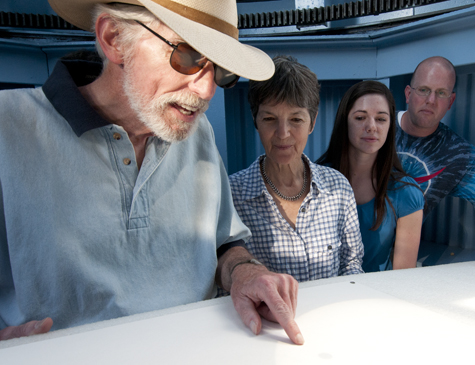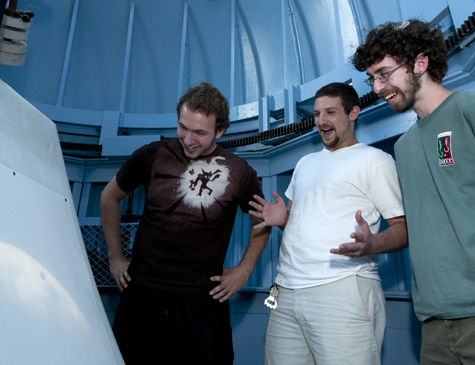 WUSTL neighbor Talmage Newton (above left) points out the path of Venus across the sun at the Crow Observatory June 5. The observatory was open to the public for a viewing of the twice-per-century transit of Venus across the sun. The transits come in pairs eight years apart at intervals of a little more than 100 years. Because the transit was the second of a pair, the next one won’t occur until 2117. Crow Hall’s 154-year-old Yeatman telescope projected an image of the sun about two feet in diameter that several people could simultaneously and safely view. On this solar image, Venus appeared as a black disk almost the size of a quarter. Also clearly visible were several sunspots — regions of the sun where strong magnetic fields keep the surface a little cooler, and thus darker, than most of the photosphere. Joining Newton were (from left) Anne Dollimore, a WUSTL neighbor, Samantha Karlow, a sophomore in pre-med and Brian Rauch, PhD, a post-doctoral research associate in physics in Arts & Sciences. Also viewing the transit were (bottom, from left) students Jordan Raisher, Adam Trebach and David Goldfinger, all seniors majoring in physics in Arts & Sciences. Credit: Kevin Lowder (2)
WUSTL neighbor Talmage Newton (above left) points out the path of Venus across the sun at the Crow Observatory June 5. The observatory was open to the public for a viewing of the twice-per-century transit of Venus across the sun. The transits come in pairs eight years apart at intervals of a little more than 100 years. Because the transit was the second of a pair, the next one won’t occur until 2117. Crow Hall’s 154-year-old Yeatman telescope projected an image of the sun about two feet in diameter that several people could simultaneously and safely view. On this solar image, Venus appeared as a black disk almost the size of a quarter. Also clearly visible were several sunspots — regions of the sun where strong magnetic fields keep the surface a little cooler, and thus darker, than most of the photosphere. Joining Newton were (from left) Anne Dollimore, a WUSTL neighbor, Samantha Karlow, a sophomore in pre-med and Brian Rauch, PhD, a post-doctoral research associate in physics in Arts & Sciences. Also viewing the transit were (bottom, from left) students Jordan Raisher, Adam Trebach and David Goldfinger, all seniors majoring in physics in Arts & Sciences. Credit: Kevin Lowder (2)